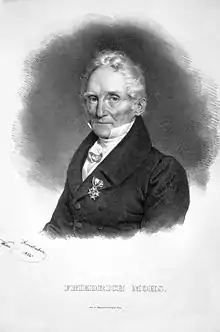Friedrich Mohs
Carl Friedrich Christian Mohs (German: [moːs]; 29 January 1773 – 29 September 1839) was a German chemist and mineralogist. He was the creator of the Mohs scale of mineral hardness.[1] Mohs also introduced a classification of the crystal forms in crystal systems independently of Christian Samuel Weiss.[2]
Friedrich Mohs | |
|---|---|
 Friedrich Mohs, 1832 | |
| Born | 29 January 1773 |
| Died | 29 September 1839 (aged 66) |
| Alma mater | University of Halle |
| Known for | Mohs scale of mineral hardness |
| Scientific career | |
| Fields | geology, mineralogy |
Early life
Mohs was born in Gernrode, in the Harz mountains, Germany.[3] He showed an interest in science at an early age and received private education before entering the University of Halle.[4]
Education
Mohs studied chemistry, mathematics and physics at the University of Halle.[3] In 1798 he joined the Mining Academy in Freiberg, Saxony, being a student of Abraham Gottlob Werner.[3]
Career
After acquiring the job of a foreman at a mine in 1801, Mohs relocated in 1802 to Austria, where he was employed in trying to identify the minerals in a private collection of the banker J. F. van der Nüll.[3] Mohs described this collection, and a catalogue was printed and published.[5] In 1812 he relocated to Graz where he was employed by Archduke Johann in his newly established museum and academy of science, which was divided subsequently into the Joanneum and the Graz University of Technology. In 1818 Mohs was appointed successor of his former professor at the Freiberg Mining Academy, A. G. Werner, who died in 1817.[3][6] In 1826 Mohs became full professor of mineralogy at the University of Vienna.[6] At the same time he was assigned curator of the Imperial Mineralogical Collection, into which the van der Nüll collection of minerals was incorporated in 1827.[7] In 1835 Mohs resigned.[3] He became Bergrat which meant being an imperial counselor in charge of mining affairs,[3] published by orders from his department an instruction on mining,[5] and was commissioned with the establishment of a montanistic museum in Vienna.[7]
Mineral properties

As part of this task, he started classifying minerals by their physical characteristics, instead of their chemical composition, as had been done traditionally. This emphasis on physical characteristics was at odds with the prevailing chemical systematics. However, both Theophrastus and Pliny the Elder had compared the relative hardness of minerals known to them during ancient times, including diamond and quartz. They knew that diamond could scratch quartz, so showing it to be harder. This became the basis of the hardness scale developed by Mohs. The hardest mineral, diamond, was given a value of 10 and softer minerals such as talc were given the value of 1. Other minerals were given values intermediate, depending on their ability to scratch another mineral in the scale. Thus gypsum was given the value 2 because it will scratch talc crystals, and calcite the value 3 because it will scratch gypsum. Minerals are also now classified by chemical characteristics, but the physical properties are still useful for field examination.
In 1812, Mohs became a professor in Graz.[3] In 1818, Mohs was appointed professor at his alma mater in Freiberg.[3] In 1826, Mohs was a professor in Vienna.[3]
Personal life
In 1816, Mohs settled in Vienna. In 1818, Mohs relocated to Freiberg, Saxony. Mohs died during a journey to Agordo, Italy in 1839, at the age of 66.
Notes
- Authier 2013, p. 349.
- Authier 2013, p. 349–350.
- Authier 2013, p. 350.
- "Friedrich Mohs | Encyclopedia.com". www.encyclopedia.com. Retrieved 24 January 2019.
- "Friedrich Mohs". Biographisches Lexikon des Kaiserthums Oesterreich. images 451–456. Retrieved 12 February 2019.
- J. Zemann. "Mohs, Friedrich". Österreichisches Biographisches Lexikon ab 1815 (online) (in German). Vol. 6. Austrian Academy of Sciences. p. 345.
- "Friedrich Mohs". Natural History Museum, Vienna. Retrieved 12 February 2019.
Sources
- Authier, André (2013). Early Days of X-ray Crystallography. Oxford University Press. ISBN 978-0-19-965984-5.
Further reading
- Wilhelm von Gümbel: "Mohs, Friedrich". In: Allgemeine Deutsche Biographie. Vol. 22, Duncker & Humblot, Leipzig 1885, pp. 76–79.
- "Friedrich Mohs" in Austria-Forum (in German) (at AEIOU)
- Johannes Uray, "Chemische Theorie und mineralogische Klassifikationssysteme von der chemischen Revolution bis zur Mitte des 19. Jahrhunderts". In: Berhard Hubmann, Elmar Schübl, Johannes Seidl (eds.), Die Anfänge geologischer Forschung in Österreich. Beiträge zur Tagung "10 Jahre Arbeitsgruppe Geschichte der Erdwissenschaften Österreichs" von 24. bis 26. April 2009 in Graz. Graz 2010, pp. 107–125.
External links
 Media related to Friedrich Mohs at Wikimedia Commons
Media related to Friedrich Mohs at Wikimedia Commons